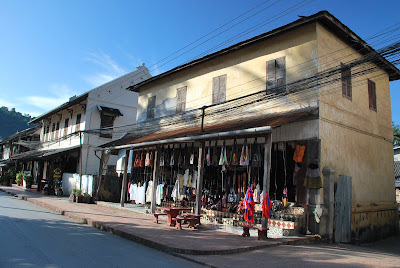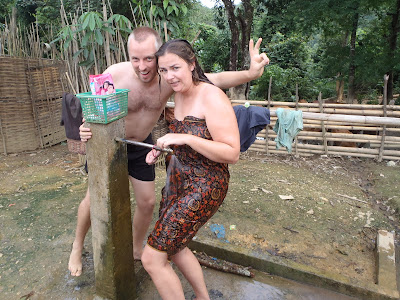
Three years ago I wouldn’t have thought that the best French food I would have in Southeast Asia would be in Vientiane. Actually, three years ago I probably wouldn’t have thought that I’d be eating French food anywhere in Asia. I guess if there’s anything positive to say about the lasting legacy of an oppressive French colonial regime, it’s the appreciation and availability of mouth-watering flanks of beef covered in Roquefort cheese sauce.
After spending a late afternoon and evening in the (mostly) empty streets of Laos’ capital, Laura, my sister, Heather, and myself made our way to the Vientiane domestic airport early the next morning. The airport’s concrete bunker exterior was a good indication of what to expect from the interior, which resembled more a dingy bus station somewhere in the outer fringes of Western Sichuan than what one would normally expect from the central hub of the country’s leading domestic airline. To be fair, it’s the country’s leading airline chiefly because it’s the country’s only airline with a fleet of maybe four planes, but let’s not get into semantics here.

An hour later we were in the country’s spiritual and tourist centre – the beautiful town of Luang Prabang. Situated in northern Laos on the banks of where the Mekong and Nam Ou rivers converge, the town has the unique distinction of making you feel like you’re in Laos while at the same time making you feel like you’re not in Laos. The latter sensation a result of the fact that out of any Asian ‘city’ (the word ‘city’ in Laos can really only be used as an approximate euphemism when referring to anywhere in Laos populated by more than twenty people), Luang Prabang is the most calm and laid back, which certainly sets it apart from the thunderous cacophony of sounds, horrendous smells and walls of people that typify the average Asian city. What makes the town an anomaly in Laos, however, are the paved streets, lavish restaurants, tourist services and the plethora of cheap souvenirs imported from factories in China. Once we left for elsewhere in Laos, it became clear that this wasn’t the standard.





That being said, Luang Prabang is simply one of the most amazing destinations in Southeast Asia. We spent several days cycling around the town and its environs, marveling at the simple yet lavish Buddhist temples, the preserved decay of French colonial architecture, sampling incredible Lao food and soaking in the beautiful views of the Mekong River. Despite its tourist-centric economy, a casual glance down most streets in Luang Prabang would give nothing away, as buildings and storefronts must adhere to UNESCO preservation standards. Walking down the streets of town, it's not hard to feel as if you've just stumbled upon something authentic and new. It’s not until you take a closer look that you realize that a half dozen stores in a row are advertising for the same elephant trekking tours and selling the exact same brands of bottled water and soft drinks at inflated prices.




















After two days in Luang Prabang, we headed northeast to the small, riverside town of Nong Khiaw, some four hours from Luang Prabang. Here, finally, was a taste of the real Laos: dirt roads, cars up on blocks and covered in makeshift tarps, livestock roaming at will, shabbily-built homes, and a populace that seemed content with watching the day pass by listening to the rice grow. The bus station being an unfortunate two or three kilometers from the actual town centre, we marched with our heaving packs on our backs through the heat of the midday sun, passing our smiling bus driver some twenty minutes up the road as he washed clean the caked dirt from the side of his bus.


Once we’d secured a place to sleep for the night, we headed east on foot, through a dramatic landscape of lush green rice fields fringed with dense jungle and jagged limestone karsts that seemed to have clawed their way out of the earth from every direction. It was here, during the 1960s and 70s, that villagers, government officials and communist guerillas alike found shelter within the many caves and underground rivers created by these limestone formations to protect themselves from the aerial bombardment of the region by American forces during the Vietnam War. A lot was left to the imagination within the caves we explored, but that being said, the fact that we were forced to visualize how entire communities and branches of government managed to coexist and function without the standard intrusion of crude displays and hastily assembled dioramas meant for the benefit of tourists left a deeper impression on all of us.





A greater sense of the tragedy that this period in history had for the Lao people was conveyed to us through the many discussions we had with Oot, the guide we had hired in Muang Ngoi Neua, about an hour boat ride upriver from Nong Khiaw. As we left the confines of the village proper, he pointed out that up until 5 or 6 years ago, the seemingly endless acres of rice fields that we passed through on our way up into the mountains had been inaccessible due to the number of UXOs (unexploded ordinance) that lay dormant in the soil having failed to explode on impact. While this certainly did not stop all people from attempting to make a living from the land, the number of people that Oot had known growing up who had lost their limbs or their lives throughout his childhood kept him from venturing into areas that were off limits.


We had hired Oot to take us up into the mountains for a two-day trek, with an overnight stay in a remote mountain village inhabited by the Khmu tribe. One of the fascinating aspects of travelling in this part of Southeast Asia is the sheer number of ethnic minorities that populate the mountainous region that includes sections of Vietnam, Laos, Thailand, Myanmar and Southern China. While we have encountered some of these minorities in passing in places like Sapa and Chiang Mai, Laura and I had for the most part avoided the types of excursions that we felt exploited and negatively impacted these small village communities. There was something about this situation that was altogether different, however, and perhaps the sheer lack of tourists to the area and its relative isolation made the decision to venture on this trek worthwhile.


We certainly were not let down. After six or seven hours of hiking along leech-infested dirt paths, through humid swaths of dense jungle and up into the crisp air of mountain forests, we found ourselves transported to another world. Its perimeter giving way to steep slopes on either side of a fenced enclosure made up of a combination of wooden stakes, branches and mud, the isolated Khmu village was as rustic as you can get. Wood stilted homes encircled the centre of the village, which served as a thoroughfare for chickens, pigs, dogs, and villagers carrying firewood freshly cut from the mountain forests. It also served as a gathering place for children playing games of takraw, a sport that seemed to blend aspects of soccer and volleyball. A short distance from the village centre was the communal bathing and washing pit, which seemed to house the village’s sole source of running water. Wrapped in nothing but flimsy sarongs, Heather and Laura attracted a large crowd of curious villagers keen to see how the foreigners would cope bathing Lao style and in full, public view.



After we had all cleaned up, Oot led us around the village, explaining the customs and way of life that were common to people of the Khmu tribe. In the meantime, our hosts were busy preparing our dinner, which involved chasing down a chicken or two, slitting their throats, de-feathering them and roasting them over an open fire. Hours after this process had begun, we were led up to the second storey of the house we’d be sleeping in, where our hosts had laid out a whole (cooked) chicken, some uncooked rice, some string, and a full bottle of homegrown rice whiskey on a small, foot-high, wood table.
The Khmu people have deep-rooted animist beliefs, and as it turned out, the village shaman and his wife were our hosts for the evening. Before we could eat, the shaman performed a ritual blessing the food and formally welcoming us to the village. As part of this ritual, the village elders who had been invited to the dinner took turns tying the pieces of string that had been set on the table to our wrists, all the while chanting words of welcome, good luck and fortune. The final act of the ritual was to be performed by us - namely taking a shot of rice whiskey each, then passing it around until the bottle was emptied.
Throughout dinner, Oot acted as our translator, and despite the obvious language barrier, we were made to feel like apart of the family. We immediately fell in love with the family’s matriarch, and promptly adopted her as our new grandma. When she wasn’t flashing her toothless gums in a burst of hearty laughter, she was belting out words of wisdom and advice that more or less fell in line with what grandmas the globe over are known to say: “Eat more! You’re too skinny!” “Hurry up and have some babies!” “Make sure you treat your wife well!” She alone was worth the cost of the entire trek and the physical exertion to actually get to her village.













(Heather and Laura posing with 'Grandma')
The next morning we awoke to the sounds of a torrential downpour that would turn out to last much of the day. The dirt grounds of the village had turned to a thick, sticky sludge that would cling and compound on the bottom of my boots with each step I took. With little prospect of the rain letting up, we decided to proceed, not knowing until much later on that our guide had never taken trekkers downhill in conditions like these before. Our progress was incredibly slow, as we shimmied down steep slopes and along narrow trails that had either become small, fast running streams or slick mudslides by the time we’d reached them. We stumbled, slipped and slid our way down the mountainside, stopping occasionally to check for leeches and to wipe the excess mud off of our legs and boots. Once we’d cleared the steepest sections of the trail, we then found ourselves wading through rivers and dense foliage, all the while fighting off the insects and heat that had emerged with the arrival of the sun some hours after we’d left the village. By the time we’d reached the banks of the Nam Ou River, I had nothing left. I was starving, sore, filthy and exhausted – all signs of a worthwhile trip.






No comments:
Post a Comment